BMP4005 - Information Systems & Big Data Analysis - IT Solutions
VerifiedAdded on 2023/06/14
|11
|3420
|194
Report
AI Summary
This report examines the role of information systems in supporting management decisions and explores various IT solutions. It discusses theories and techniques related to the design and development of IT solutions like Microsoft Office and Moodle, and analyzes different information systems such as DSS, ESS, TPS, MIS, and KSM. The report also investigates the effects of IT on globalization, defines digital infrastructure with a focus on mobile telecommunications, and outlines the risks associated with outsourcing information systems. The importance of IT infrastructure in digital transformation is also highlighted. The report uses Hyperlink InfoSystem as a case study to illustrate practical applications of these concepts.
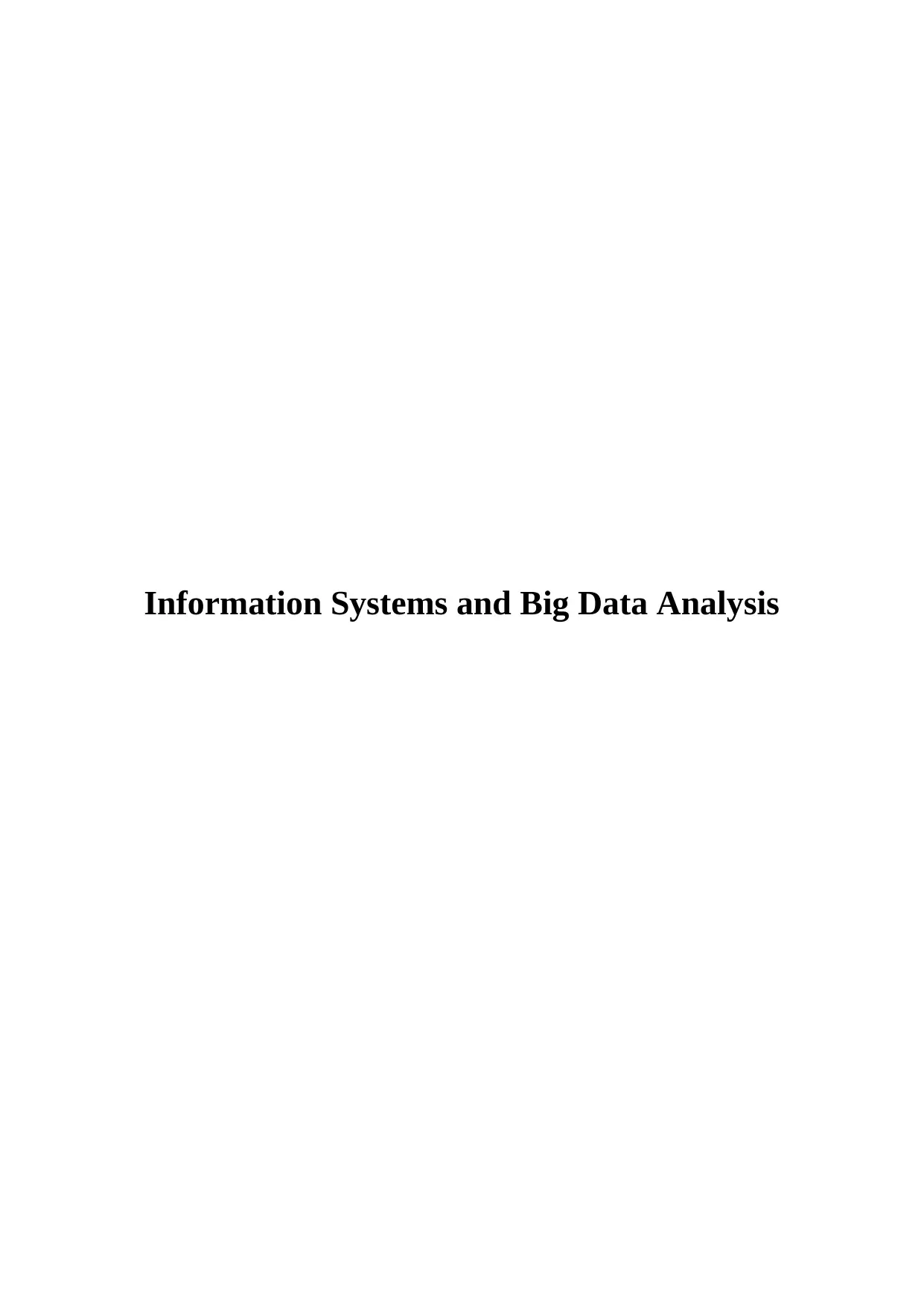
Information Systems and Big Data Analysis
Paraphrase This Document
Need a fresh take? Get an instant paraphrase of this document with our AI Paraphraser
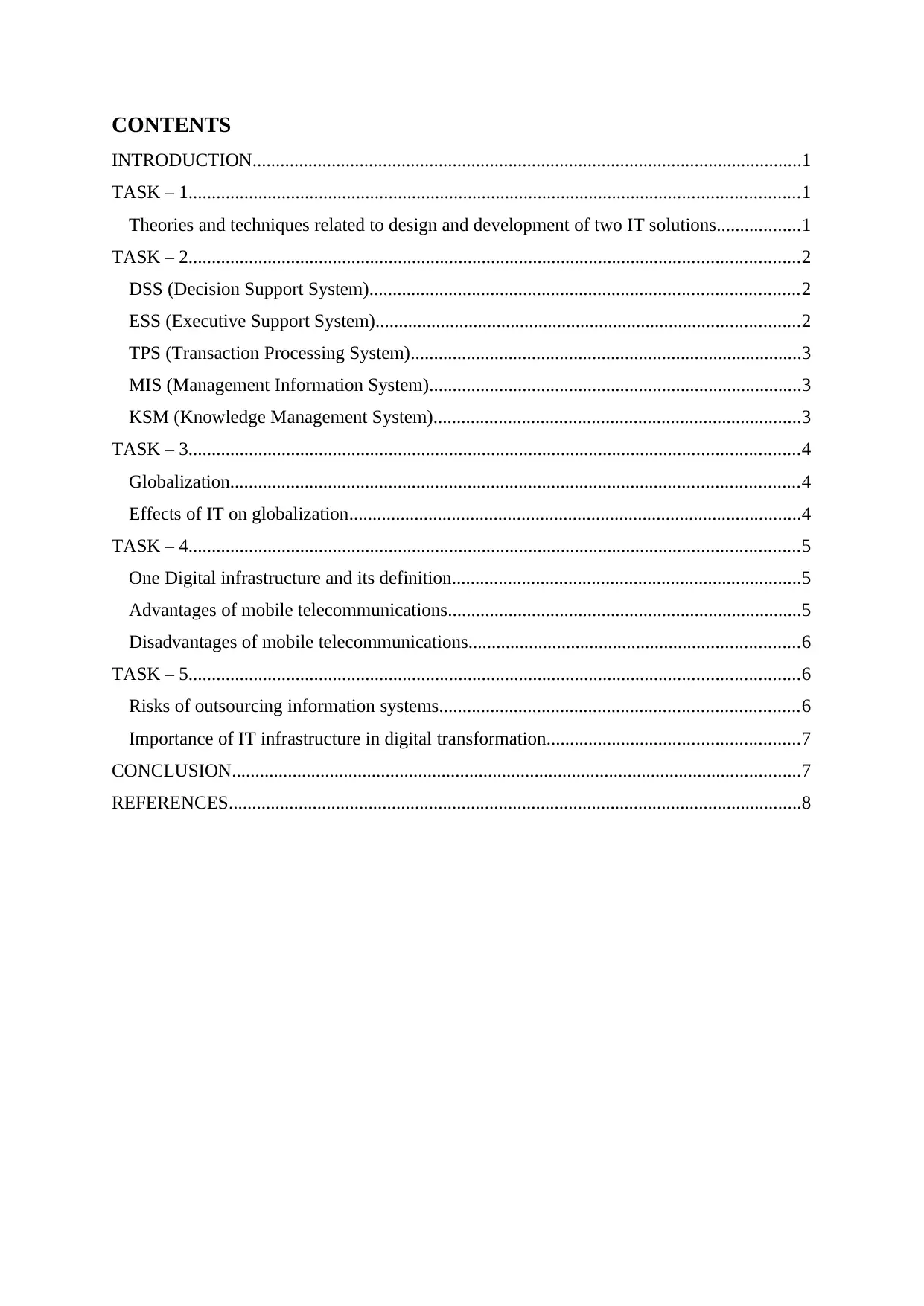
CONTENTS
INTRODUCTION......................................................................................................................1
TASK – 1...................................................................................................................................1
Theories and techniques related to design and development of two IT solutions..................1
TASK – 2...................................................................................................................................2
DSS (Decision Support System)............................................................................................2
ESS (Executive Support System)...........................................................................................2
TPS (Transaction Processing System)....................................................................................3
MIS (Management Information System)................................................................................3
KSM (Knowledge Management System)...............................................................................3
TASK – 3...................................................................................................................................4
Globalization..........................................................................................................................4
Effects of IT on globalization.................................................................................................4
TASK – 4...................................................................................................................................5
One Digital infrastructure and its definition...........................................................................5
Advantages of mobile telecommunications............................................................................5
Disadvantages of mobile telecommunications.......................................................................6
TASK – 5...................................................................................................................................6
Risks of outsourcing information systems.............................................................................6
Importance of IT infrastructure in digital transformation......................................................7
CONCLUSION..........................................................................................................................7
REFERENCES...........................................................................................................................8
INTRODUCTION......................................................................................................................1
TASK – 1...................................................................................................................................1
Theories and techniques related to design and development of two IT solutions..................1
TASK – 2...................................................................................................................................2
DSS (Decision Support System)............................................................................................2
ESS (Executive Support System)...........................................................................................2
TPS (Transaction Processing System)....................................................................................3
MIS (Management Information System)................................................................................3
KSM (Knowledge Management System)...............................................................................3
TASK – 3...................................................................................................................................4
Globalization..........................................................................................................................4
Effects of IT on globalization.................................................................................................4
TASK – 4...................................................................................................................................5
One Digital infrastructure and its definition...........................................................................5
Advantages of mobile telecommunications............................................................................5
Disadvantages of mobile telecommunications.......................................................................6
TASK – 5...................................................................................................................................6
Risks of outsourcing information systems.............................................................................6
Importance of IT infrastructure in digital transformation......................................................7
CONCLUSION..........................................................................................................................7
REFERENCES...........................................................................................................................8
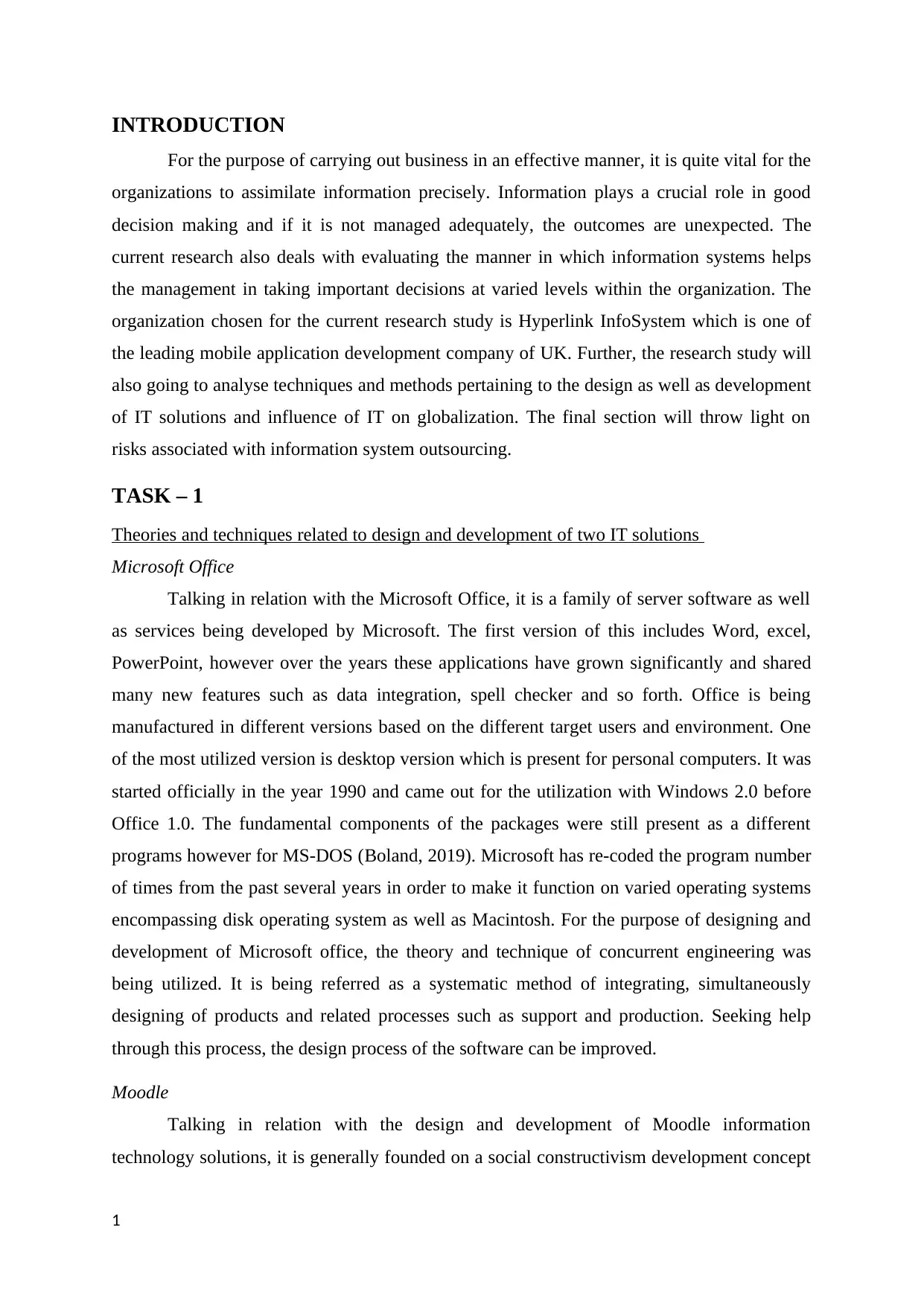
INTRODUCTION
For the purpose of carrying out business in an effective manner, it is quite vital for the
organizations to assimilate information precisely. Information plays a crucial role in good
decision making and if it is not managed adequately, the outcomes are unexpected. The
current research also deals with evaluating the manner in which information systems helps
the management in taking important decisions at varied levels within the organization. The
organization chosen for the current research study is Hyperlink InfoSystem which is one of
the leading mobile application development company of UK. Further, the research study will
also going to analyse techniques and methods pertaining to the design as well as development
of IT solutions and influence of IT on globalization. The final section will throw light on
risks associated with information system outsourcing.
TASK – 1
Theories and techniques related to design and development of two IT solutions
Microsoft Office
Talking in relation with the Microsoft Office, it is a family of server software as well
as services being developed by Microsoft. The first version of this includes Word, excel,
PowerPoint, however over the years these applications have grown significantly and shared
many new features such as data integration, spell checker and so forth. Office is being
manufactured in different versions based on the different target users and environment. One
of the most utilized version is desktop version which is present for personal computers. It was
started officially in the year 1990 and came out for the utilization with Windows 2.0 before
Office 1.0. The fundamental components of the packages were still present as a different
programs however for MS-DOS (Boland, 2019). Microsoft has re-coded the program number
of times from the past several years in order to make it function on varied operating systems
encompassing disk operating system as well as Macintosh. For the purpose of designing and
development of Microsoft office, the theory and technique of concurrent engineering was
being utilized. It is being referred as a systematic method of integrating, simultaneously
designing of products and related processes such as support and production. Seeking help
through this process, the design process of the software can be improved.
Moodle
Talking in relation with the design and development of Moodle information
technology solutions, it is generally founded on a social constructivism development concept
1
For the purpose of carrying out business in an effective manner, it is quite vital for the
organizations to assimilate information precisely. Information plays a crucial role in good
decision making and if it is not managed adequately, the outcomes are unexpected. The
current research also deals with evaluating the manner in which information systems helps
the management in taking important decisions at varied levels within the organization. The
organization chosen for the current research study is Hyperlink InfoSystem which is one of
the leading mobile application development company of UK. Further, the research study will
also going to analyse techniques and methods pertaining to the design as well as development
of IT solutions and influence of IT on globalization. The final section will throw light on
risks associated with information system outsourcing.
TASK – 1
Theories and techniques related to design and development of two IT solutions
Microsoft Office
Talking in relation with the Microsoft Office, it is a family of server software as well
as services being developed by Microsoft. The first version of this includes Word, excel,
PowerPoint, however over the years these applications have grown significantly and shared
many new features such as data integration, spell checker and so forth. Office is being
manufactured in different versions based on the different target users and environment. One
of the most utilized version is desktop version which is present for personal computers. It was
started officially in the year 1990 and came out for the utilization with Windows 2.0 before
Office 1.0. The fundamental components of the packages were still present as a different
programs however for MS-DOS (Boland, 2019). Microsoft has re-coded the program number
of times from the past several years in order to make it function on varied operating systems
encompassing disk operating system as well as Macintosh. For the purpose of designing and
development of Microsoft office, the theory and technique of concurrent engineering was
being utilized. It is being referred as a systematic method of integrating, simultaneously
designing of products and related processes such as support and production. Seeking help
through this process, the design process of the software can be improved.
Moodle
Talking in relation with the design and development of Moodle information
technology solutions, it is generally founded on a social constructivism development concept
1
⊘ This is a preview!⊘
Do you want full access?
Subscribe today to unlock all pages.

Trusted by 1+ million students worldwide
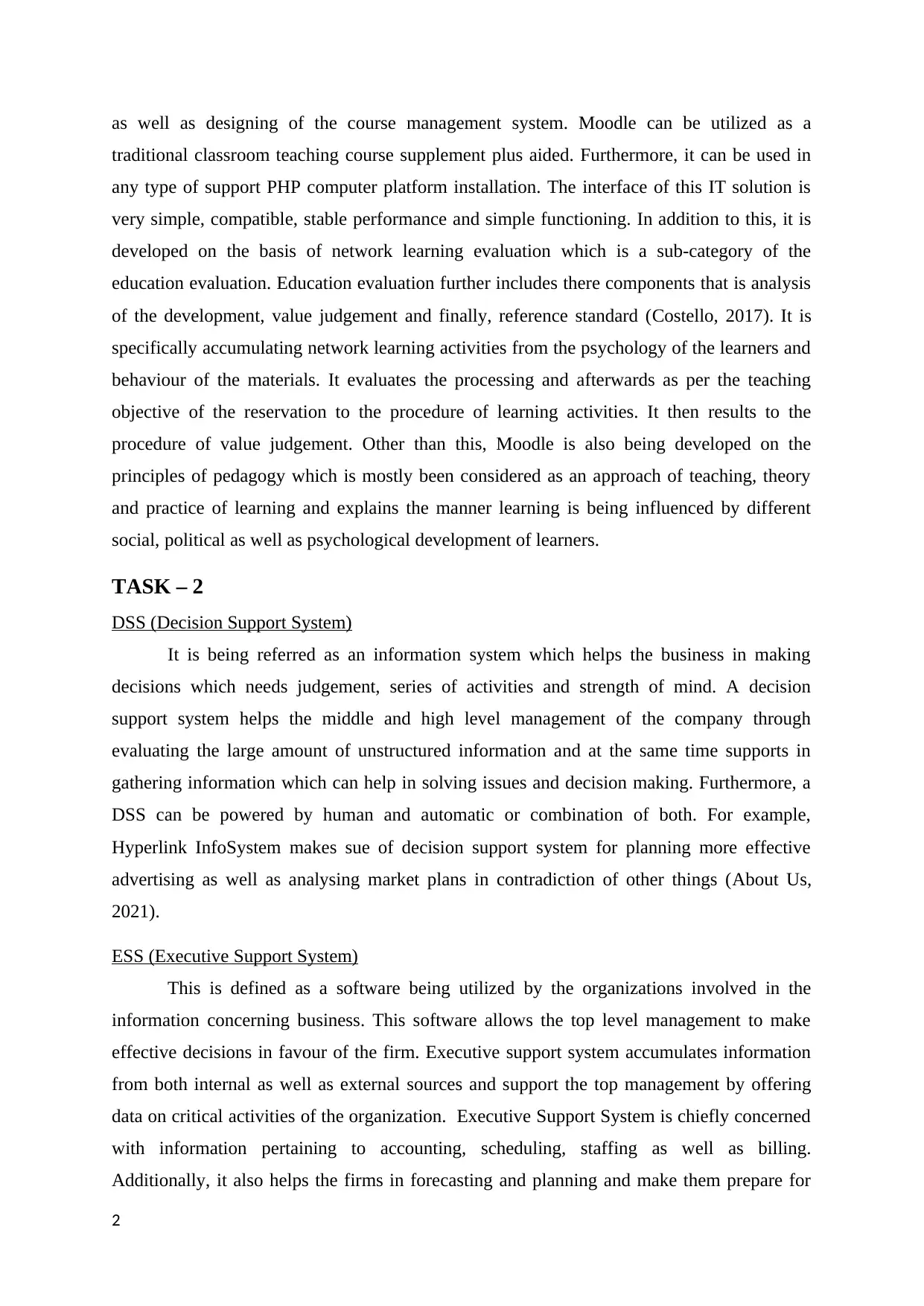
as well as designing of the course management system. Moodle can be utilized as a
traditional classroom teaching course supplement plus aided. Furthermore, it can be used in
any type of support PHP computer platform installation. The interface of this IT solution is
very simple, compatible, stable performance and simple functioning. In addition to this, it is
developed on the basis of network learning evaluation which is a sub-category of the
education evaluation. Education evaluation further includes there components that is analysis
of the development, value judgement and finally, reference standard (Costello, 2017). It is
specifically accumulating network learning activities from the psychology of the learners and
behaviour of the materials. It evaluates the processing and afterwards as per the teaching
objective of the reservation to the procedure of learning activities. It then results to the
procedure of value judgement. Other than this, Moodle is also being developed on the
principles of pedagogy which is mostly been considered as an approach of teaching, theory
and practice of learning and explains the manner learning is being influenced by different
social, political as well as psychological development of learners.
TASK – 2
DSS (Decision Support System)
It is being referred as an information system which helps the business in making
decisions which needs judgement, series of activities and strength of mind. A decision
support system helps the middle and high level management of the company through
evaluating the large amount of unstructured information and at the same time supports in
gathering information which can help in solving issues and decision making. Furthermore, a
DSS can be powered by human and automatic or combination of both. For example,
Hyperlink InfoSystem makes sue of decision support system for planning more effective
advertising as well as analysing market plans in contradiction of other things (About Us,
2021).
ESS (Executive Support System)
This is defined as a software being utilized by the organizations involved in the
information concerning business. This software allows the top level management to make
effective decisions in favour of the firm. Executive support system accumulates information
from both internal as well as external sources and support the top management by offering
data on critical activities of the organization. Executive Support System is chiefly concerned
with information pertaining to accounting, scheduling, staffing as well as billing.
Additionally, it also helps the firms in forecasting and planning and make them prepare for
2
traditional classroom teaching course supplement plus aided. Furthermore, it can be used in
any type of support PHP computer platform installation. The interface of this IT solution is
very simple, compatible, stable performance and simple functioning. In addition to this, it is
developed on the basis of network learning evaluation which is a sub-category of the
education evaluation. Education evaluation further includes there components that is analysis
of the development, value judgement and finally, reference standard (Costello, 2017). It is
specifically accumulating network learning activities from the psychology of the learners and
behaviour of the materials. It evaluates the processing and afterwards as per the teaching
objective of the reservation to the procedure of learning activities. It then results to the
procedure of value judgement. Other than this, Moodle is also being developed on the
principles of pedagogy which is mostly been considered as an approach of teaching, theory
and practice of learning and explains the manner learning is being influenced by different
social, political as well as psychological development of learners.
TASK – 2
DSS (Decision Support System)
It is being referred as an information system which helps the business in making
decisions which needs judgement, series of activities and strength of mind. A decision
support system helps the middle and high level management of the company through
evaluating the large amount of unstructured information and at the same time supports in
gathering information which can help in solving issues and decision making. Furthermore, a
DSS can be powered by human and automatic or combination of both. For example,
Hyperlink InfoSystem makes sue of decision support system for planning more effective
advertising as well as analysing market plans in contradiction of other things (About Us,
2021).
ESS (Executive Support System)
This is defined as a software being utilized by the organizations involved in the
information concerning business. This software allows the top level management to make
effective decisions in favour of the firm. Executive support system accumulates information
from both internal as well as external sources and support the top management by offering
data on critical activities of the organization. Executive Support System is chiefly concerned
with information pertaining to accounting, scheduling, staffing as well as billing.
Additionally, it also helps the firms in forecasting and planning and make them prepare for
2
Paraphrase This Document
Need a fresh take? Get an instant paraphrase of this document with our AI Paraphraser
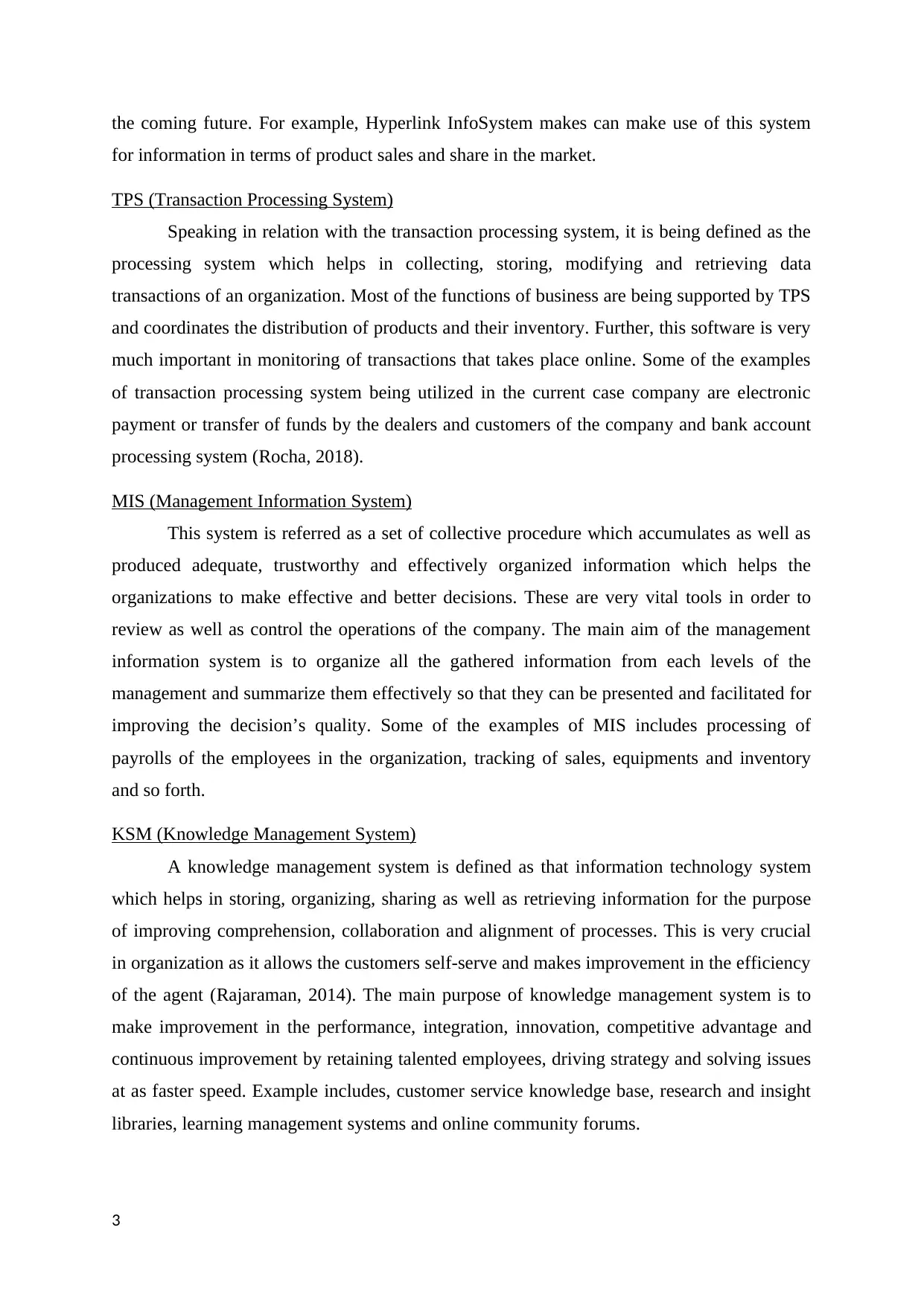
the coming future. For example, Hyperlink InfoSystem makes can make use of this system
for information in terms of product sales and share in the market.
TPS (Transaction Processing System)
Speaking in relation with the transaction processing system, it is being defined as the
processing system which helps in collecting, storing, modifying and retrieving data
transactions of an organization. Most of the functions of business are being supported by TPS
and coordinates the distribution of products and their inventory. Further, this software is very
much important in monitoring of transactions that takes place online. Some of the examples
of transaction processing system being utilized in the current case company are electronic
payment or transfer of funds by the dealers and customers of the company and bank account
processing system (Rocha, 2018).
MIS (Management Information System)
This system is referred as a set of collective procedure which accumulates as well as
produced adequate, trustworthy and effectively organized information which helps the
organizations to make effective and better decisions. These are very vital tools in order to
review as well as control the operations of the company. The main aim of the management
information system is to organize all the gathered information from each levels of the
management and summarize them effectively so that they can be presented and facilitated for
improving the decision’s quality. Some of the examples of MIS includes processing of
payrolls of the employees in the organization, tracking of sales, equipments and inventory
and so forth.
KSM (Knowledge Management System)
A knowledge management system is defined as that information technology system
which helps in storing, organizing, sharing as well as retrieving information for the purpose
of improving comprehension, collaboration and alignment of processes. This is very crucial
in organization as it allows the customers self-serve and makes improvement in the efficiency
of the agent (Rajaraman, 2014). The main purpose of knowledge management system is to
make improvement in the performance, integration, innovation, competitive advantage and
continuous improvement by retaining talented employees, driving strategy and solving issues
at as faster speed. Example includes, customer service knowledge base, research and insight
libraries, learning management systems and online community forums.
3
for information in terms of product sales and share in the market.
TPS (Transaction Processing System)
Speaking in relation with the transaction processing system, it is being defined as the
processing system which helps in collecting, storing, modifying and retrieving data
transactions of an organization. Most of the functions of business are being supported by TPS
and coordinates the distribution of products and their inventory. Further, this software is very
much important in monitoring of transactions that takes place online. Some of the examples
of transaction processing system being utilized in the current case company are electronic
payment or transfer of funds by the dealers and customers of the company and bank account
processing system (Rocha, 2018).
MIS (Management Information System)
This system is referred as a set of collective procedure which accumulates as well as
produced adequate, trustworthy and effectively organized information which helps the
organizations to make effective and better decisions. These are very vital tools in order to
review as well as control the operations of the company. The main aim of the management
information system is to organize all the gathered information from each levels of the
management and summarize them effectively so that they can be presented and facilitated for
improving the decision’s quality. Some of the examples of MIS includes processing of
payrolls of the employees in the organization, tracking of sales, equipments and inventory
and so forth.
KSM (Knowledge Management System)
A knowledge management system is defined as that information technology system
which helps in storing, organizing, sharing as well as retrieving information for the purpose
of improving comprehension, collaboration and alignment of processes. This is very crucial
in organization as it allows the customers self-serve and makes improvement in the efficiency
of the agent (Rajaraman, 2014). The main purpose of knowledge management system is to
make improvement in the performance, integration, innovation, competitive advantage and
continuous improvement by retaining talented employees, driving strategy and solving issues
at as faster speed. Example includes, customer service knowledge base, research and insight
libraries, learning management systems and online community forums.
3
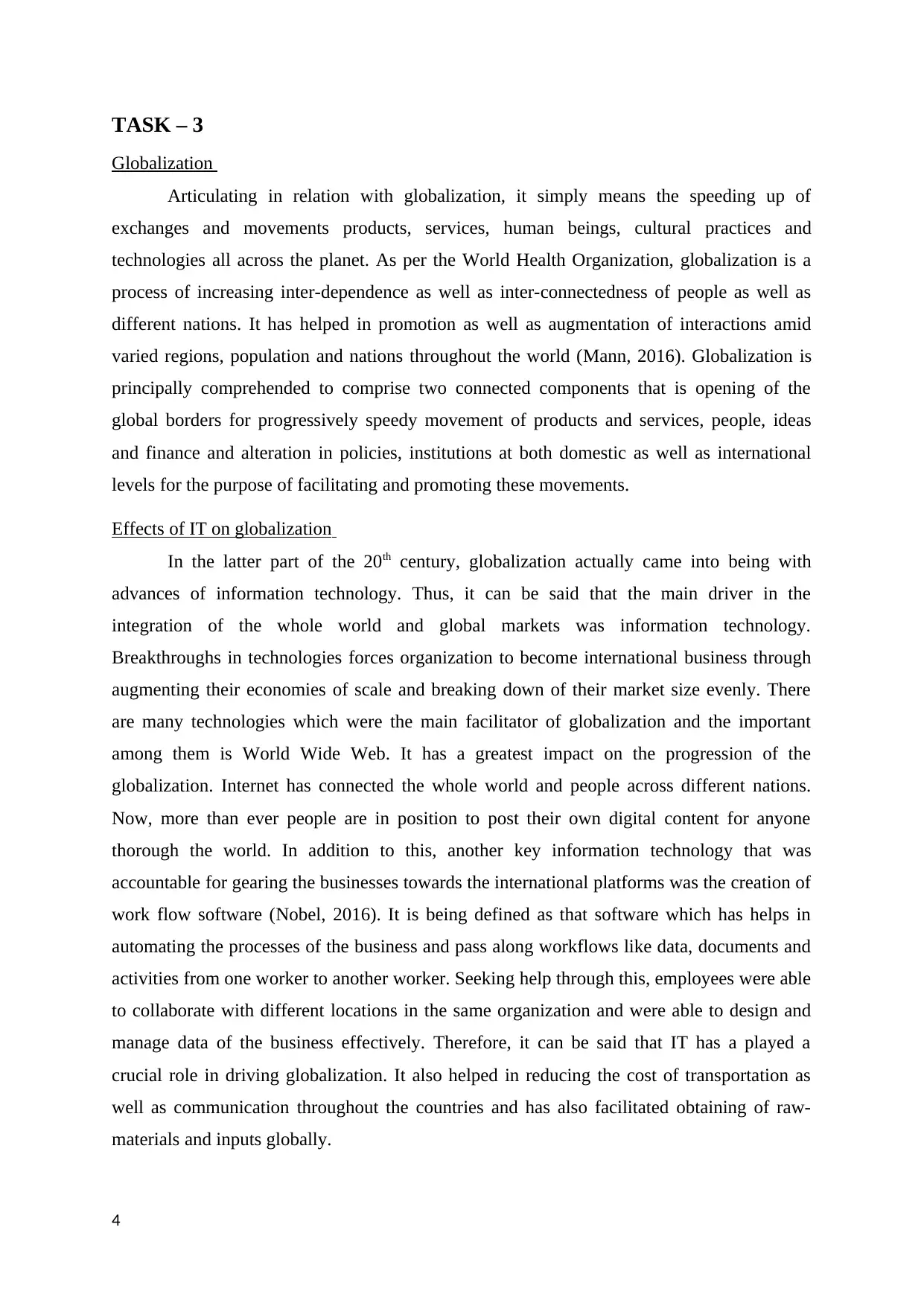
TASK – 3
Globalization
Articulating in relation with globalization, it simply means the speeding up of
exchanges and movements products, services, human beings, cultural practices and
technologies all across the planet. As per the World Health Organization, globalization is a
process of increasing inter-dependence as well as inter-connectedness of people as well as
different nations. It has helped in promotion as well as augmentation of interactions amid
varied regions, population and nations throughout the world (Mann, 2016). Globalization is
principally comprehended to comprise two connected components that is opening of the
global borders for progressively speedy movement of products and services, people, ideas
and finance and alteration in policies, institutions at both domestic as well as international
levels for the purpose of facilitating and promoting these movements.
Effects of IT on globalization
In the latter part of the 20th century, globalization actually came into being with
advances of information technology. Thus, it can be said that the main driver in the
integration of the whole world and global markets was information technology.
Breakthroughs in technologies forces organization to become international business through
augmenting their economies of scale and breaking down of their market size evenly. There
are many technologies which were the main facilitator of globalization and the important
among them is World Wide Web. It has a greatest impact on the progression of the
globalization. Internet has connected the whole world and people across different nations.
Now, more than ever people are in position to post their own digital content for anyone
thorough the world. In addition to this, another key information technology that was
accountable for gearing the businesses towards the international platforms was the creation of
work flow software (Nobel, 2016). It is being defined as that software which has helps in
automating the processes of the business and pass along workflows like data, documents and
activities from one worker to another worker. Seeking help through this, employees were able
to collaborate with different locations in the same organization and were able to design and
manage data of the business effectively. Therefore, it can be said that IT has a played a
crucial role in driving globalization. It also helped in reducing the cost of transportation as
well as communication throughout the countries and has also facilitated obtaining of raw-
materials and inputs globally.
4
Globalization
Articulating in relation with globalization, it simply means the speeding up of
exchanges and movements products, services, human beings, cultural practices and
technologies all across the planet. As per the World Health Organization, globalization is a
process of increasing inter-dependence as well as inter-connectedness of people as well as
different nations. It has helped in promotion as well as augmentation of interactions amid
varied regions, population and nations throughout the world (Mann, 2016). Globalization is
principally comprehended to comprise two connected components that is opening of the
global borders for progressively speedy movement of products and services, people, ideas
and finance and alteration in policies, institutions at both domestic as well as international
levels for the purpose of facilitating and promoting these movements.
Effects of IT on globalization
In the latter part of the 20th century, globalization actually came into being with
advances of information technology. Thus, it can be said that the main driver in the
integration of the whole world and global markets was information technology.
Breakthroughs in technologies forces organization to become international business through
augmenting their economies of scale and breaking down of their market size evenly. There
are many technologies which were the main facilitator of globalization and the important
among them is World Wide Web. It has a greatest impact on the progression of the
globalization. Internet has connected the whole world and people across different nations.
Now, more than ever people are in position to post their own digital content for anyone
thorough the world. In addition to this, another key information technology that was
accountable for gearing the businesses towards the international platforms was the creation of
work flow software (Nobel, 2016). It is being defined as that software which has helps in
automating the processes of the business and pass along workflows like data, documents and
activities from one worker to another worker. Seeking help through this, employees were able
to collaborate with different locations in the same organization and were able to design and
manage data of the business effectively. Therefore, it can be said that IT has a played a
crucial role in driving globalization. It also helped in reducing the cost of transportation as
well as communication throughout the countries and has also facilitated obtaining of raw-
materials and inputs globally.
4
⊘ This is a preview!⊘
Do you want full access?
Subscribe today to unlock all pages.

Trusted by 1+ million students worldwide
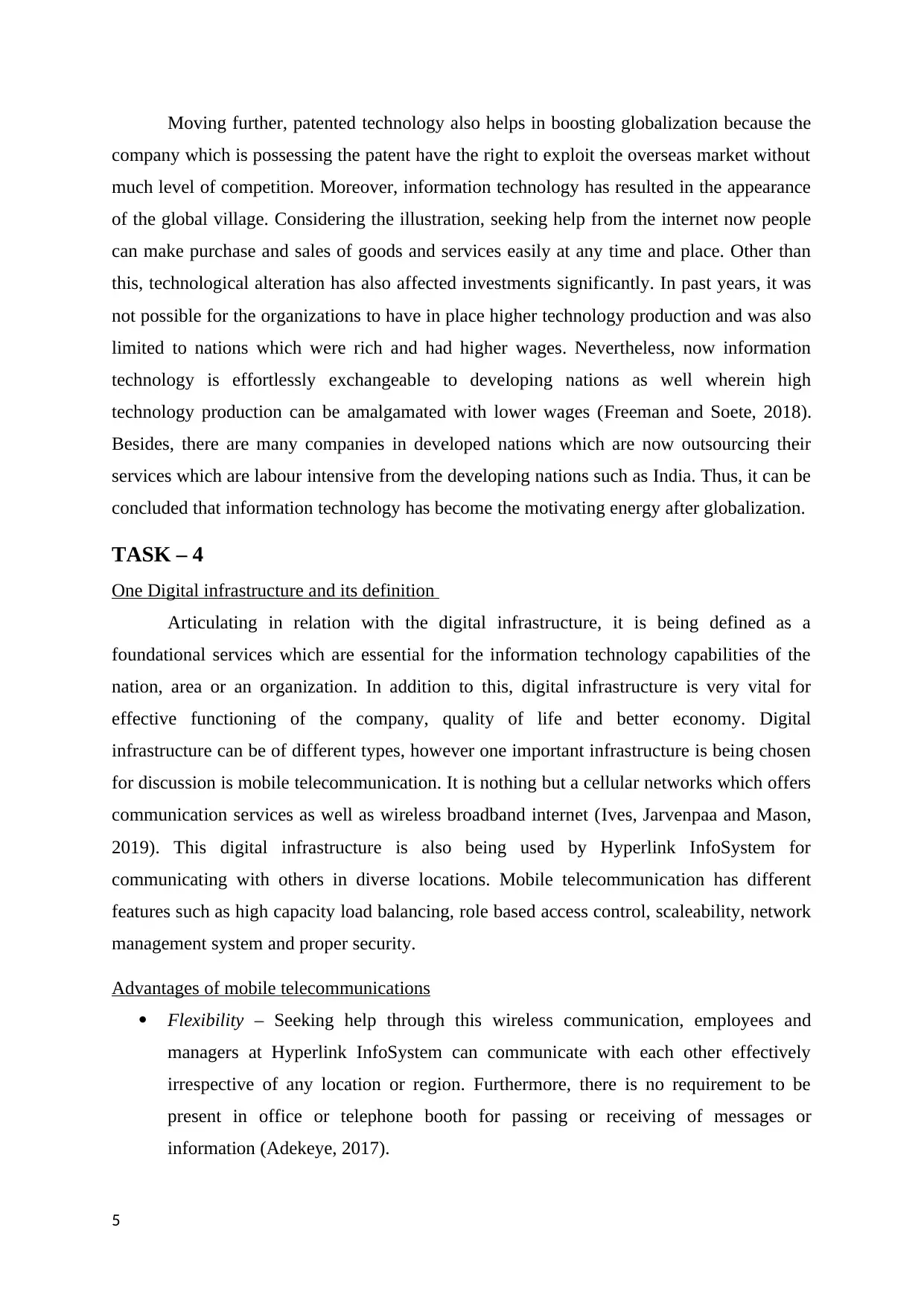
Moving further, patented technology also helps in boosting globalization because the
company which is possessing the patent have the right to exploit the overseas market without
much level of competition. Moreover, information technology has resulted in the appearance
of the global village. Considering the illustration, seeking help from the internet now people
can make purchase and sales of goods and services easily at any time and place. Other than
this, technological alteration has also affected investments significantly. In past years, it was
not possible for the organizations to have in place higher technology production and was also
limited to nations which were rich and had higher wages. Nevertheless, now information
technology is effortlessly exchangeable to developing nations as well wherein high
technology production can be amalgamated with lower wages (Freeman and Soete, 2018).
Besides, there are many companies in developed nations which are now outsourcing their
services which are labour intensive from the developing nations such as India. Thus, it can be
concluded that information technology has become the motivating energy after globalization.
TASK – 4
One Digital infrastructure and its definition
Articulating in relation with the digital infrastructure, it is being defined as a
foundational services which are essential for the information technology capabilities of the
nation, area or an organization. In addition to this, digital infrastructure is very vital for
effective functioning of the company, quality of life and better economy. Digital
infrastructure can be of different types, however one important infrastructure is being chosen
for discussion is mobile telecommunication. It is nothing but a cellular networks which offers
communication services as well as wireless broadband internet (Ives, Jarvenpaa and Mason,
2019). This digital infrastructure is also being used by Hyperlink InfoSystem for
communicating with others in diverse locations. Mobile telecommunication has different
features such as high capacity load balancing, role based access control, scaleability, network
management system and proper security.
Advantages of mobile telecommunications
Flexibility – Seeking help through this wireless communication, employees and
managers at Hyperlink InfoSystem can communicate with each other effectively
irrespective of any location or region. Furthermore, there is no requirement to be
present in office or telephone booth for passing or receiving of messages or
information (Adekeye, 2017).
5
company which is possessing the patent have the right to exploit the overseas market without
much level of competition. Moreover, information technology has resulted in the appearance
of the global village. Considering the illustration, seeking help from the internet now people
can make purchase and sales of goods and services easily at any time and place. Other than
this, technological alteration has also affected investments significantly. In past years, it was
not possible for the organizations to have in place higher technology production and was also
limited to nations which were rich and had higher wages. Nevertheless, now information
technology is effortlessly exchangeable to developing nations as well wherein high
technology production can be amalgamated with lower wages (Freeman and Soete, 2018).
Besides, there are many companies in developed nations which are now outsourcing their
services which are labour intensive from the developing nations such as India. Thus, it can be
concluded that information technology has become the motivating energy after globalization.
TASK – 4
One Digital infrastructure and its definition
Articulating in relation with the digital infrastructure, it is being defined as a
foundational services which are essential for the information technology capabilities of the
nation, area or an organization. In addition to this, digital infrastructure is very vital for
effective functioning of the company, quality of life and better economy. Digital
infrastructure can be of different types, however one important infrastructure is being chosen
for discussion is mobile telecommunication. It is nothing but a cellular networks which offers
communication services as well as wireless broadband internet (Ives, Jarvenpaa and Mason,
2019). This digital infrastructure is also being used by Hyperlink InfoSystem for
communicating with others in diverse locations. Mobile telecommunication has different
features such as high capacity load balancing, role based access control, scaleability, network
management system and proper security.
Advantages of mobile telecommunications
Flexibility – Seeking help through this wireless communication, employees and
managers at Hyperlink InfoSystem can communicate with each other effectively
irrespective of any location or region. Furthermore, there is no requirement to be
present in office or telephone booth for passing or receiving of messages or
information (Adekeye, 2017).
5
Paraphrase This Document
Need a fresh take? Get an instant paraphrase of this document with our AI Paraphraser
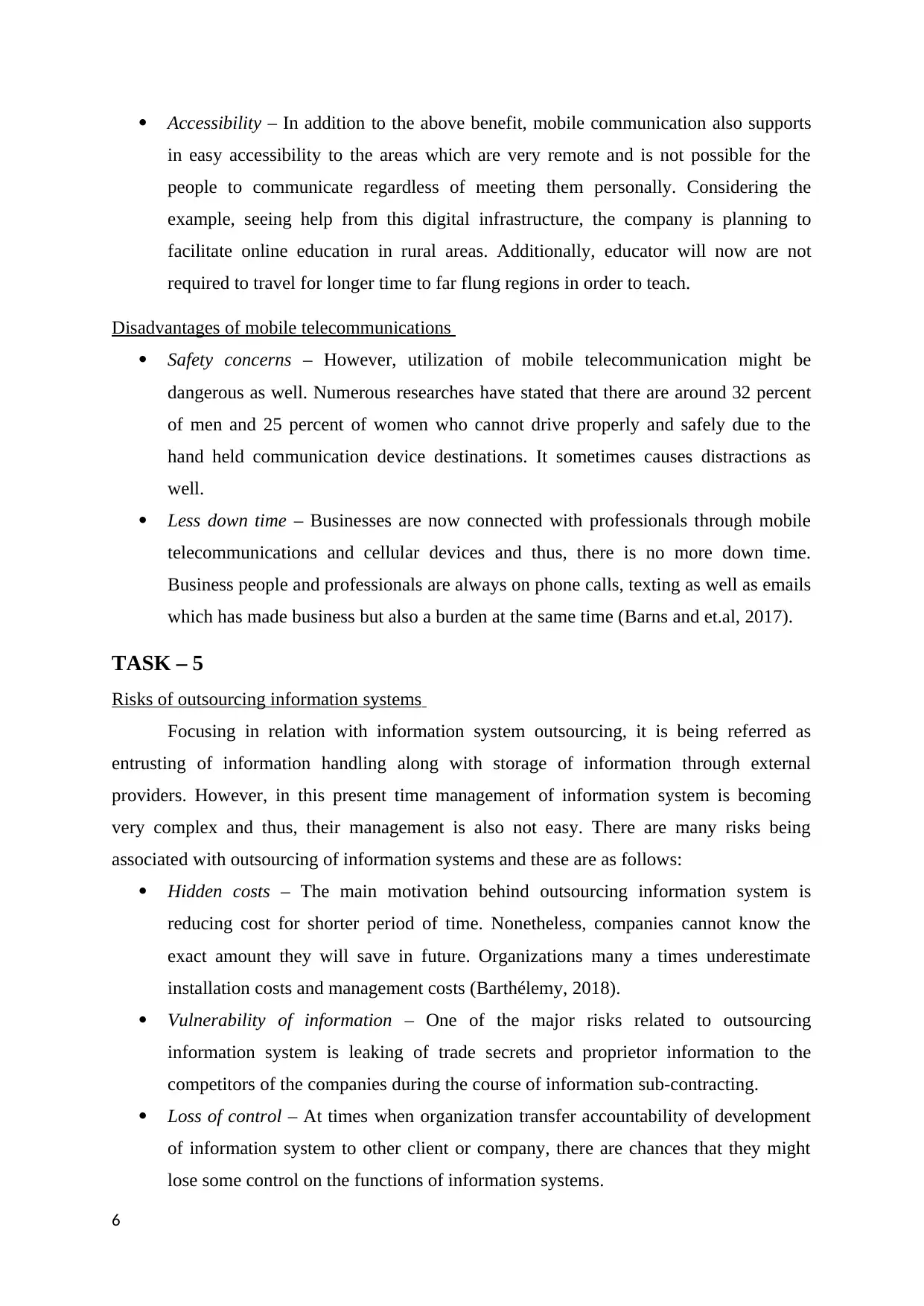
Accessibility – In addition to the above benefit, mobile communication also supports
in easy accessibility to the areas which are very remote and is not possible for the
people to communicate regardless of meeting them personally. Considering the
example, seeing help from this digital infrastructure, the company is planning to
facilitate online education in rural areas. Additionally, educator will now are not
required to travel for longer time to far flung regions in order to teach.
Disadvantages of mobile telecommunications
Safety concerns – However, utilization of mobile telecommunication might be
dangerous as well. Numerous researches have stated that there are around 32 percent
of men and 25 percent of women who cannot drive properly and safely due to the
hand held communication device destinations. It sometimes causes distractions as
well.
Less down time – Businesses are now connected with professionals through mobile
telecommunications and cellular devices and thus, there is no more down time.
Business people and professionals are always on phone calls, texting as well as emails
which has made business but also a burden at the same time (Barns and et.al, 2017).
TASK – 5
Risks of outsourcing information systems
Focusing in relation with information system outsourcing, it is being referred as
entrusting of information handling along with storage of information through external
providers. However, in this present time management of information system is becoming
very complex and thus, their management is also not easy. There are many risks being
associated with outsourcing of information systems and these are as follows:
Hidden costs – The main motivation behind outsourcing information system is
reducing cost for shorter period of time. Nonetheless, companies cannot know the
exact amount they will save in future. Organizations many a times underestimate
installation costs and management costs (Barthélemy, 2018).
Vulnerability of information – One of the major risks related to outsourcing
information system is leaking of trade secrets and proprietor information to the
competitors of the companies during the course of information sub-contracting.
Loss of control – At times when organization transfer accountability of development
of information system to other client or company, there are chances that they might
lose some control on the functions of information systems.
6
in easy accessibility to the areas which are very remote and is not possible for the
people to communicate regardless of meeting them personally. Considering the
example, seeing help from this digital infrastructure, the company is planning to
facilitate online education in rural areas. Additionally, educator will now are not
required to travel for longer time to far flung regions in order to teach.
Disadvantages of mobile telecommunications
Safety concerns – However, utilization of mobile telecommunication might be
dangerous as well. Numerous researches have stated that there are around 32 percent
of men and 25 percent of women who cannot drive properly and safely due to the
hand held communication device destinations. It sometimes causes distractions as
well.
Less down time – Businesses are now connected with professionals through mobile
telecommunications and cellular devices and thus, there is no more down time.
Business people and professionals are always on phone calls, texting as well as emails
which has made business but also a burden at the same time (Barns and et.al, 2017).
TASK – 5
Risks of outsourcing information systems
Focusing in relation with information system outsourcing, it is being referred as
entrusting of information handling along with storage of information through external
providers. However, in this present time management of information system is becoming
very complex and thus, their management is also not easy. There are many risks being
associated with outsourcing of information systems and these are as follows:
Hidden costs – The main motivation behind outsourcing information system is
reducing cost for shorter period of time. Nonetheless, companies cannot know the
exact amount they will save in future. Organizations many a times underestimate
installation costs and management costs (Barthélemy, 2018).
Vulnerability of information – One of the major risks related to outsourcing
information system is leaking of trade secrets and proprietor information to the
competitors of the companies during the course of information sub-contracting.
Loss of control – At times when organization transfer accountability of development
of information system to other client or company, there are chances that they might
lose some control on the functions of information systems.
6
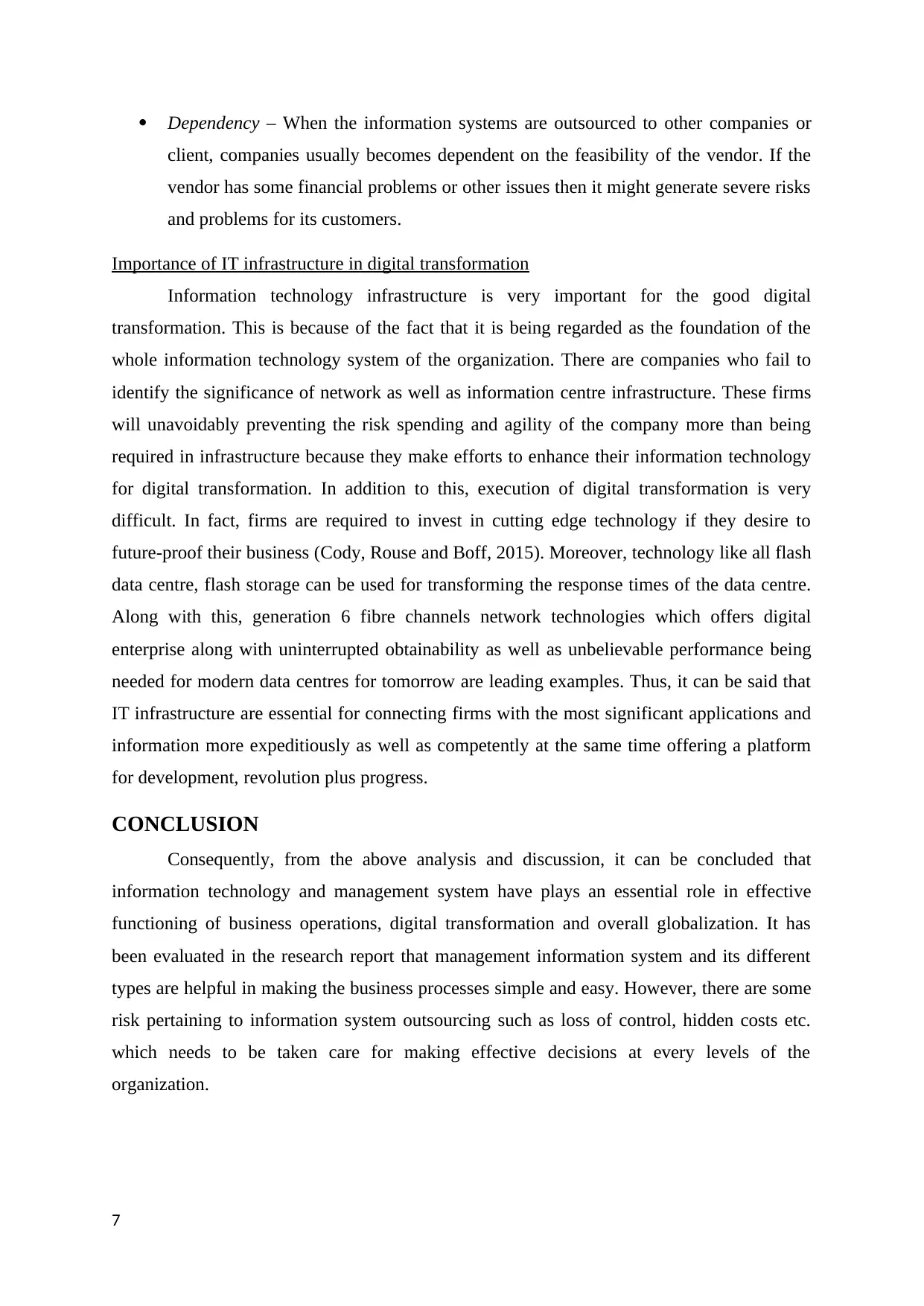
Dependency – When the information systems are outsourced to other companies or
client, companies usually becomes dependent on the feasibility of the vendor. If the
vendor has some financial problems or other issues then it might generate severe risks
and problems for its customers.
Importance of IT infrastructure in digital transformation
Information technology infrastructure is very important for the good digital
transformation. This is because of the fact that it is being regarded as the foundation of the
whole information technology system of the organization. There are companies who fail to
identify the significance of network as well as information centre infrastructure. These firms
will unavoidably preventing the risk spending and agility of the company more than being
required in infrastructure because they make efforts to enhance their information technology
for digital transformation. In addition to this, execution of digital transformation is very
difficult. In fact, firms are required to invest in cutting edge technology if they desire to
future-proof their business (Cody, Rouse and Boff, 2015). Moreover, technology like all flash
data centre, flash storage can be used for transforming the response times of the data centre.
Along with this, generation 6 fibre channels network technologies which offers digital
enterprise along with uninterrupted obtainability as well as unbelievable performance being
needed for modern data centres for tomorrow are leading examples. Thus, it can be said that
IT infrastructure are essential for connecting firms with the most significant applications and
information more expeditiously as well as competently at the same time offering a platform
for development, revolution plus progress.
CONCLUSION
Consequently, from the above analysis and discussion, it can be concluded that
information technology and management system have plays an essential role in effective
functioning of business operations, digital transformation and overall globalization. It has
been evaluated in the research report that management information system and its different
types are helpful in making the business processes simple and easy. However, there are some
risk pertaining to information system outsourcing such as loss of control, hidden costs etc.
which needs to be taken care for making effective decisions at every levels of the
organization.
7
client, companies usually becomes dependent on the feasibility of the vendor. If the
vendor has some financial problems or other issues then it might generate severe risks
and problems for its customers.
Importance of IT infrastructure in digital transformation
Information technology infrastructure is very important for the good digital
transformation. This is because of the fact that it is being regarded as the foundation of the
whole information technology system of the organization. There are companies who fail to
identify the significance of network as well as information centre infrastructure. These firms
will unavoidably preventing the risk spending and agility of the company more than being
required in infrastructure because they make efforts to enhance their information technology
for digital transformation. In addition to this, execution of digital transformation is very
difficult. In fact, firms are required to invest in cutting edge technology if they desire to
future-proof their business (Cody, Rouse and Boff, 2015). Moreover, technology like all flash
data centre, flash storage can be used for transforming the response times of the data centre.
Along with this, generation 6 fibre channels network technologies which offers digital
enterprise along with uninterrupted obtainability as well as unbelievable performance being
needed for modern data centres for tomorrow are leading examples. Thus, it can be said that
IT infrastructure are essential for connecting firms with the most significant applications and
information more expeditiously as well as competently at the same time offering a platform
for development, revolution plus progress.
CONCLUSION
Consequently, from the above analysis and discussion, it can be concluded that
information technology and management system have plays an essential role in effective
functioning of business operations, digital transformation and overall globalization. It has
been evaluated in the research report that management information system and its different
types are helpful in making the business processes simple and easy. However, there are some
risk pertaining to information system outsourcing such as loss of control, hidden costs etc.
which needs to be taken care for making effective decisions at every levels of the
organization.
7
⊘ This is a preview!⊘
Do you want full access?
Subscribe today to unlock all pages.

Trusted by 1+ million students worldwide
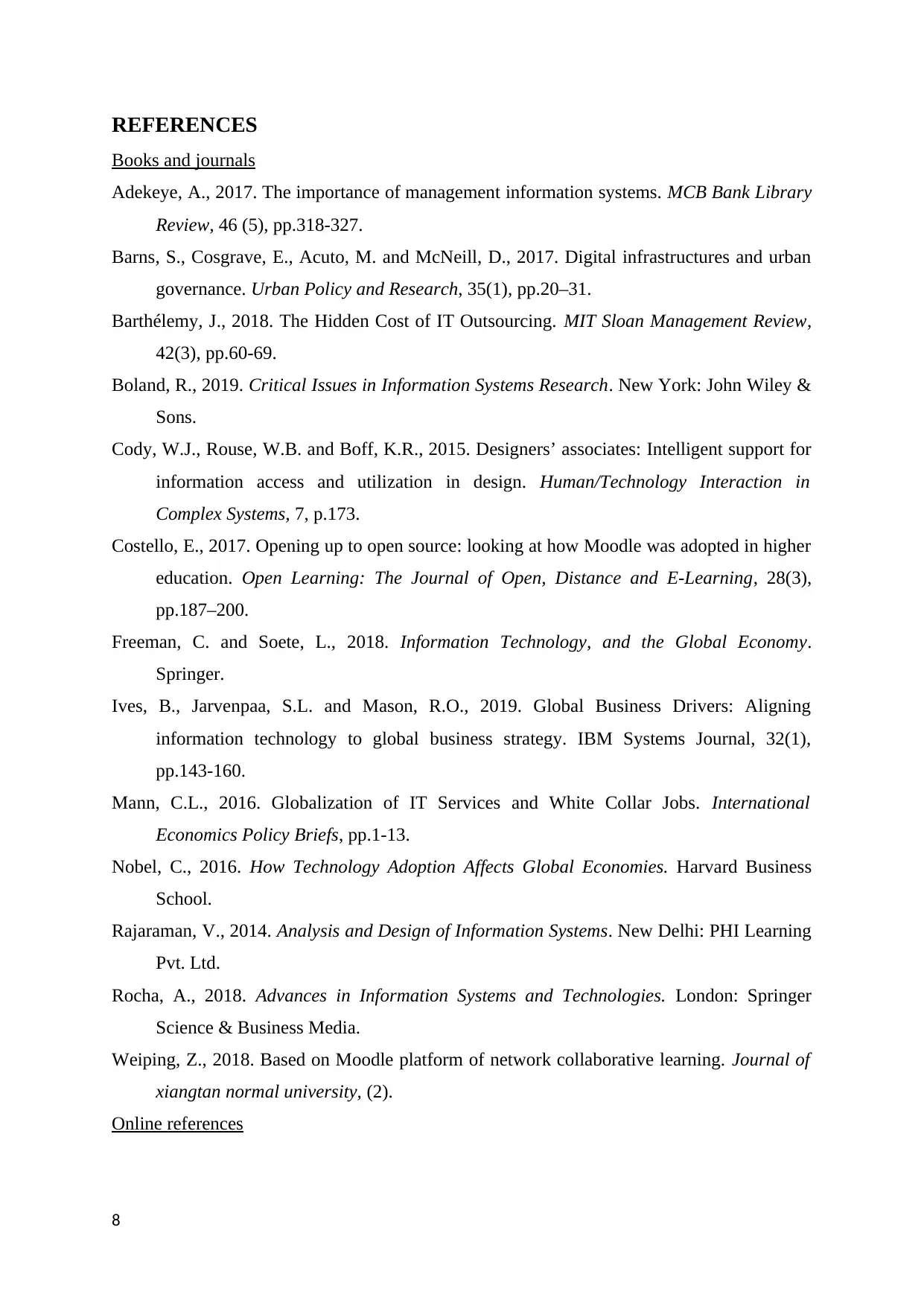
REFERENCES
Books and journals
Adekeye, A., 2017. The importance of management information systems. MCB Bank Library
Review, 46 (5), pp.318-327.
Barns, S., Cosgrave, E., Acuto, M. and McNeill, D., 2017. Digital infrastructures and urban
governance. Urban Policy and Research, 35(1), pp.20–31.
Barthélemy, J., 2018. The Hidden Cost of IT Outsourcing. MIT Sloan Management Review,
42(3), pp.60-69.
Boland, R., 2019. Critical Issues in Information Systems Research. New York: John Wiley &
Sons.
Cody, W.J., Rouse, W.B. and Boff, K.R., 2015. Designers’ associates: Intelligent support for
information access and utilization in design. Human/Technology Interaction in
Complex Systems, 7, p.173.
Costello, E., 2017. Opening up to open source: looking at how Moodle was adopted in higher
education. Open Learning: The Journal of Open, Distance and E-Learning, 28(3),
pp.187–200.
Freeman, C. and Soete, L., 2018. Information Technology, and the Global Economy.
Springer.
Ives, B., Jarvenpaa, S.L. and Mason, R.O., 2019. Global Business Drivers: Aligning
information technology to global business strategy. IBM Systems Journal, 32(1),
pp.143-160.
Mann, C.L., 2016. Globalization of IT Services and White Collar Jobs. International
Economics Policy Briefs, pp.1-13.
Nobel, C., 2016. How Technology Adoption Affects Global Economies. Harvard Business
School.
Rajaraman, V., 2014. Analysis and Design of Information Systems. New Delhi: PHI Learning
Pvt. Ltd.
Rocha, A., 2018. Advances in Information Systems and Technologies. London: Springer
Science & Business Media.
Weiping, Z., 2018. Based on Moodle platform of network collaborative learning. Journal of
xiangtan normal university, (2).
Online references
8
Books and journals
Adekeye, A., 2017. The importance of management information systems. MCB Bank Library
Review, 46 (5), pp.318-327.
Barns, S., Cosgrave, E., Acuto, M. and McNeill, D., 2017. Digital infrastructures and urban
governance. Urban Policy and Research, 35(1), pp.20–31.
Barthélemy, J., 2018. The Hidden Cost of IT Outsourcing. MIT Sloan Management Review,
42(3), pp.60-69.
Boland, R., 2019. Critical Issues in Information Systems Research. New York: John Wiley &
Sons.
Cody, W.J., Rouse, W.B. and Boff, K.R., 2015. Designers’ associates: Intelligent support for
information access and utilization in design. Human/Technology Interaction in
Complex Systems, 7, p.173.
Costello, E., 2017. Opening up to open source: looking at how Moodle was adopted in higher
education. Open Learning: The Journal of Open, Distance and E-Learning, 28(3),
pp.187–200.
Freeman, C. and Soete, L., 2018. Information Technology, and the Global Economy.
Springer.
Ives, B., Jarvenpaa, S.L. and Mason, R.O., 2019. Global Business Drivers: Aligning
information technology to global business strategy. IBM Systems Journal, 32(1),
pp.143-160.
Mann, C.L., 2016. Globalization of IT Services and White Collar Jobs. International
Economics Policy Briefs, pp.1-13.
Nobel, C., 2016. How Technology Adoption Affects Global Economies. Harvard Business
School.
Rajaraman, V., 2014. Analysis and Design of Information Systems. New Delhi: PHI Learning
Pvt. Ltd.
Rocha, A., 2018. Advances in Information Systems and Technologies. London: Springer
Science & Business Media.
Weiping, Z., 2018. Based on Moodle platform of network collaborative learning. Journal of
xiangtan normal university, (2).
Online references
8
Paraphrase This Document
Need a fresh take? Get an instant paraphrase of this document with our AI Paraphraser

About Us. 2021. [Online]. Available through: < https://www.hyperlinkinfosystem.co.uk/>.
[Accessed on 20thJanuary 2022].
9
[Accessed on 20thJanuary 2022].
9
1 out of 11
Related Documents
Your All-in-One AI-Powered Toolkit for Academic Success.
+13062052269
info@desklib.com
Available 24*7 on WhatsApp / Email
![[object Object]](/_next/static/media/star-bottom.7253800d.svg)
Unlock your academic potential
Copyright © 2020–2025 A2Z Services. All Rights Reserved. Developed and managed by ZUCOL.


